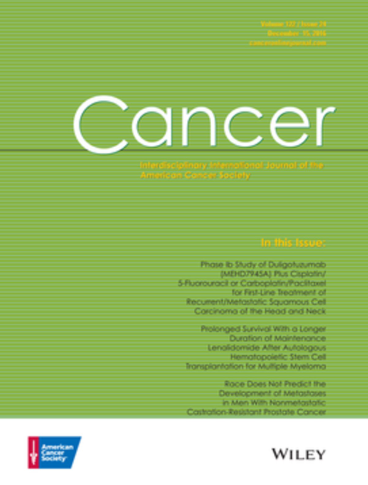A retrospective study of outcomes across time and treatment regimens in newly diagnosed, FMS-like tyrosine kinase 3 (FLT3)-mutated acute myeloid leukemia
Abstract
Background
FMS-like tyrosine kinase 3 (FLT3) mutations, either internal tandem duplications (FLT3-ITD) or tyrosine kinase domain (FLT3-TKD), are common in acute myeloid leukemia (AML). FLT3-ITD confers an adverse prognosis.
Methods
The authors performed a retrospective study including 619 patients to evaluate outcomes in newly diagnosed FLT3-mutated AML across treatment regimens.
Results
In patients with FLT3-ITD–mutated AML who received intensive chemotherapy (IC), the addition of a FLT3 inhibitor (FLT3i) was associated with trends toward improved relapse-free survival (median 32.3 vs. 14.3 months with vs. without a FLT3i; p = .055) and overall survival (OS; 35.5 vs. 18.9 months with vs. without a FLT3i; p = .098). In patients with FLT3-ITD mutations who received low-intensity (LIT) regimens, triplets (LIT plus a FLT3i plus venetoclax) were associated with significantly longer OS (19.1 months) compared with those who received other treatment combinations (11.2 months with LIT alone, 9.2 months with LIT plus FLT3i, and 10.3 months with LIT plus venetoclax). Patients with FLT3-ITD plus NPM1 co-mutations who received any therapy had a trend toward improved OS (2-year OS: 47% vs. 33%; p = .087). The FLT3-ITD allelic ratio; IDH1, IDH2, WT1, RUNX1, and myelodysplastic syndrome-related mutations; and adverse cytogenetics had no significant impact on OS. In landmark analyses, allogeneic stem cell transplantation was associated with a trend toward improved OS in patients with FLT3-ITD mutations who received IC (52.6 vs. 22.7 months with versus without allogeneic stem cell transplantation; p = .076) and a marked improvement in OS in those who received LIT (38.6 vs. 14.0 months with vs. without allogeneic stem cell transplantation; p < .0001).
Conclusions
A FLT3i and allogeneic stem cell transplantation are key treatment modalities for patients who have FLT3-mutated AML. LIT-based triplets are promising in IC-ineligible patients.

 求助内容:
求助内容: 应助结果提醒方式:
应助结果提醒方式:


